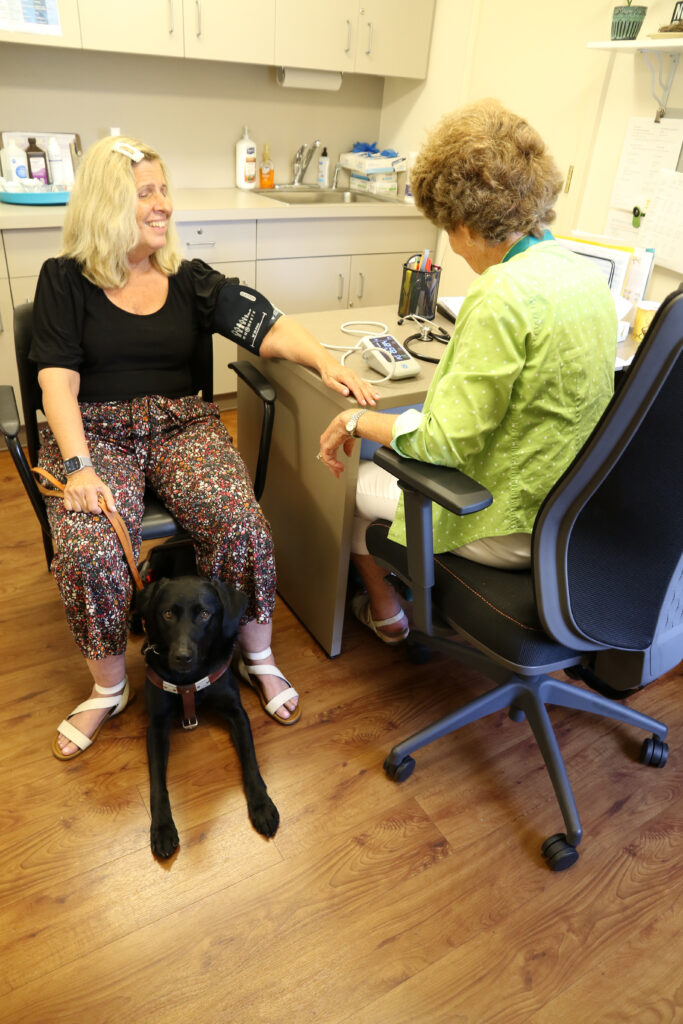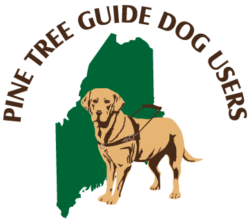Patients who are blind or have low vision may be accompanied by a guide dog when visiting healthcare facilities. Here are some helpful tips to ensure the experience goes smoothly for all.

Please Ignore the Guide Dog
Some patients rely on a guide dog to help them move about safely and independently. You can easily recognize a guide dog by its specialized harness with a long handle. When encountering a patient with a guide dog, please:
• Resist the urge to touch, talk to, or otherwise try to interact with the guide dog. Distracting the dog from its work can be unsafe.
• Avoid lengthy inquiries about the guide dog. While patients often enjoy a few quick remarks about their dog, most prefer to focus on the reason for their visit.
• Notify the patient if the guide dog gets in the way. If the dog moves from its place during an exam or procedure, ignore the dog and let the patient know.
• Alert the patient if you are fearful of dogs. An open discussion will help identify the best way to manage the situation.
Escorting Patients
When moving from one area to the next, some patients may prefer to grasp your left arm just above the elbow while they heel their guide dog. Others will direct their dog to “follow” behind you. When the patient chooses to follow:
• Walk at your normal speed unless the patient lags behind.
• Provide verbal instructions directly to the patient. Never call the dog or otherwise try to get it to follow you by making noises, clapping hands, etc. Likewise, do not grab the dog’s leash or harness in an attempt to “steer” the patient.
• Alert the patient before you make turns or go through doorways and other tight areas. Using terms like right and left are more helpful than “turn here” or “over there.”
• Maintain a conversation as you move along to provide the patient with audible clues to your location.
Download Our Flyer
Download and print the PDF version of this tip sheet and share with your healthcare provider (portrait format).
You may also wish to visit the American Foundation for the Blind to find more general guidance on best practices for low vision and blind individuals in healthcare settings.
Other Resources about Service Animals in Healthcare Settings
Accommodating Service Animals in Healthcare Settings
This fact sheet developed by the U.S. Dept. of Health and Human Services is intended to provide policy guidance when interacting with an individual using a service animal, with a particular emphasis on the health care setting during a disaster or emergency.
Environmental Infection Control Guidelines for Service Animals
Section 3 of the CDC Environmental Infection Control Guidelines for animals in Healthcare Facilities specifically addresses the presence of service animals. It offers detailed guidance for safe practices concerning access for patients, visitors, and employees with service animals.
ADA Revised Requirements: Service Animals
This publication from the U.S. Department of Justice provides general information about the access rights of disabled people with service animals and the ADA. One example specifically references hospitals, stating that “in a hospital it usually would be inappropriate to exclude a service animal from areas such as patient rooms, clinics, cafeterias, or examination rooms. However, it may be appropriate to exclude a service animal from operating rooms or burn units where the animal’s presence may compromise a sterile environment.”
Frequently Asked Questions about Service Animals and the ADA
This publication from the U.S. Department of Justice provides guidance on the ADA’s service animal provisions and should be read in conjunction with the publication, ADA Revised Requirements: Service Animals. Questions 14 through 16 provide specific information about the presence of service animals in healthcare settings including whether or not a hospital has to allow an in-patient with a disability to keep a service animal in his or her room; what happens if a patient who uses a service animal is admitted to the hospital and is unable to care for or supervise their animal; and if a service animal must be allowed to ride in an ambulance with its handler.
Service Animals in Veterans Affairs Facilities
This publication from the U.S. Department of Veterans Affairs outlines access requirements for individuals with service dogs in VA health facilities, Vet Centers, regional offices, and other properties owned or leased by the VA. Download the Veterans Health Administration Directive for more details about the access of animals on VHA property.
